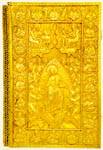|
|
| Byzantine Minor Arts |
1671 Simonopetra Monastery Silver gilt, 34.5 x 23.5 cm Anastasios Sougdouris, Venice |
|

|
On the front panel Christ in an aureola has trampled down the Gates of Hell and with a sweeping gesture is raising Adam and Eve, while the Prophet-Kings and the host of the righteous look on in awe. Seated above, within frames, are the full-length figures of the Evangelists Matthew and John, with their symbols. The whole is bordered by a vine with open flowers from which emerge the figures of saints, a motif not unusual in works of this type in this period. The back cover is dominated by the figure of the dead Christ on the Cross. On one side are the Virgin and the three women attending her, and on the other John and the centurion; behind the principal figures are a group of soldiers. Above, the Evangelists Mark and Luke with their symbols are framed against a background of imposing buildings which, representing the city of Jerusalem, constitute an integral part of the Crucifixion. The whole is surrounded by an unusual Renaissance border, with the inscription: 'Tω θη(ον) και ιερών ευαγγέλιον Γέγονεν διά χειρός Aναστασίου Tου Σουγδουρί του εξ ιωαν(νίνων) ενετίησιν 1671 σεπταιμβ(ρίου) ιστ.' (Made for the Holy Gospel by Anastasios Sougdouris of Ioannina in the year 1671, September 16). These two panels are strikingly different. While the scene of the Anastasis adheres faithfully to older, Byzantine models, the Crucifixion follows the type introduced in the second half of the fifteenth century by the painters of the Cretan School, here with the addition of details revealing a Western influence: the loin-cloth on the figure of Christ, the helmets of the soldiers and the Renaissance city in the background (Eikones 1993, no. 166, p. 520). The border, inspired by contemporary engravings, highlights the dramatic staging of the scene, in which the predominant atmosphere is one of emotion restrained. Anastasios Sougdouris of Ioannina was a descendent of a family of merchants, established in Venice since the sixteenth century. The sister of scholar George Sougdouris had married Nicholas Glykis, head of the publishing house of the same name; this marriage created close ties between the two families, and it was natural that Anastasios, a goldsmith, should be influenced by these Venetian connections. But the differences between his and contemporary Venetian silverwork, together with the lack of uniformity of style - although technical details suggest that the two pieces are not unrelated -, raise questions about where and when these two panels were made, and even suggest the possible involvement of a second craftsman. The dearth of comparable contemporary work from Ioannina, however, precludes comparisons - at least for the present. A chalice with a Slavonic inscription signed by Anastasios Sougdouris in the National Art Museum in Bucharest raises another question: that of mobility of craftsmen and artisans and the influences affecting their work (Deligiannis 1995, pp. 179, 216, 238). However that may be, the members of the Sougdouris family continued for several centuries to make names for themselves both as scholars and goldsmiths.
| |
|
Bibliography: Ikonomaki-Papadopoulos 1991, p. 165, figs. 83-4.
| ||
| Y. I.-P. | ||
| Index of exhibits of Monastery of Simonopetra 17th century |
||
Reference address : https://www.elpenor.org/athos/en/e218ci35.asp